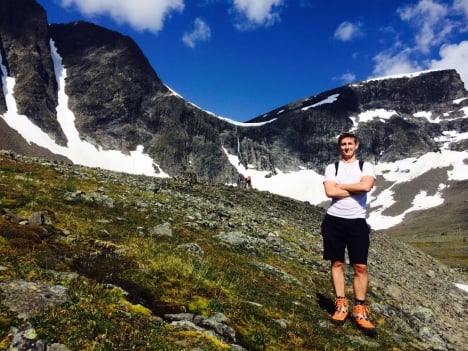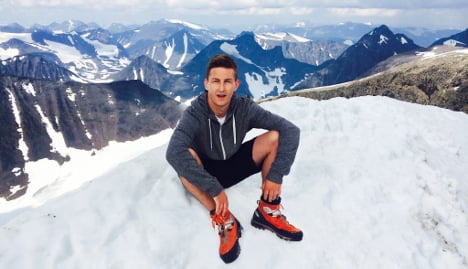I was 150 kilometres north of the Arctic circle and the mosquitoes wanted me dead. I was already itchy just minutes after leaving Nikkaluokta – a tiny dot on the map that marked the end of the road and the start of the trip.
Thwack, thwack, thwack.
I was armed with a backpack (including tent, sleeping bag, food, clothes, water, and insect repellent), my girlfriend, and a 19-kilometre trek to the base camp of Kebnekaise.
Halfway along at a lakeside pit stop, an exhausted Serb heading the other way got talking to me, scratching his festering ankles as he spoke.
“I’ll give you one word of warning, my friend” he said, thwacking a mosquito on his arm, revealing a small pool of blood.
“If you make it to the top, don’t look over the edge. I did. It’s certain death off both sides. I got a serious dose of vertigo and no one needs that in their lives.”
Lucky I’m not afraid of heights, I thought foolishly. And oh, how wrong I was.
.jpg)
The scene of the lakeside pit stop
Five hours of walking and we were at the base camp, setting up our tent. I was already struggling after lugging the gear, but glad I didn’t have to take the cheapest mattress space at the lodge for 520 kronor ($75).
The trek was a little tough on my ankles (I was wearing sneakers), and I eyed up the rack of hiking boots available for rent.
The man behind the desk laughed when I asked if the mountain would be much tougher than the hike that day.
“That first bit was a walk in the park. I could do it in flip flops. If you want to tame Kebnekaise, you’re going to need hiking boots,” he said with a smile.
These turned out to be the wisest words I’d hear. I rented the boots for 200 kronor (If you want my advice, bring sturdy boots – read my top five tips here) and we planned to set off at sunrise the next day.
.jpg)
The ascent
I learned quickly that there’s no such thing as sunrise in far northern Sweden during the summer. In fact, there’s no sunset either. Just sun, 24 hours a day. So we set off at 8.30 as a fair compromise.
I’d say there were around 50 people doing the climb that day, spaced far apart. Many of them gave up. Most, perhaps. You see, it’s a steep ten kilometres from base camp to the peak, followed by another ten on the way down. And the average hike time is around 13 hours. And on this day, the sun was pounding down.
The climb winds slowly into the mountains, and it’s several hours before you can even see the peak. Red painted dots mark the track every now and again, and it’s recommended you take a compass in case visibility is too low to see them.

See the picture above for a rough idea of the climb. First, you have to veer left, scale the lower peak (to the top left), then descend 200 metres in that big dip (oh cruel, cruel world), before hiking up the other side to the summit (far right).
And this takes hours. About seven for us. The ascent gets steeper, the rocks get looser, the running water from the melting glaciers gets scarcer, until it’s just you against the mountain. Man versus nature.
IN PICTURES: See more images from the mountain
At times, you have to cross streams, scale glaciers, and dodge tumbling rocks. You have to avoid the people turning back on the path who’ve given up, and who have defeat written all over their face.
“We’ve seen the view from here, how much better can it get,” they say. But you can see it in their eyes. Kebnekaise has claimed their souls.
But we persevered. And after about seven hours, we stumbled over a rocky ledge and saw the peak up close for the first time. Snow-capped, magnificent, and manageable.
We stopped for water, took our sweaters out of our bag and started the final ascent through the snow.
Eventually we couldn’t climb any higher. We were on the top of Sweden. We’d done it.
The view from the top of #Kebnekaise is incredible. pic.twitter.com/oURNci415N
— Oliver Gee (@TheUppsalaKoala) July 14, 2014
They say you can see ten percent of Sweden from the top of Kebnekaise and I’d believe it. But I was too numb, cold, and tired to think about percentages. Unfortunately, I was also too tired to remember the wise words of the Serb as I looked over the edge.
“Wow, look how steep it is,” I said to my girlfriend, and then immediately froze. I sat down. Off both sides of the peak, there was a sheer drop.
And it was truly frightening. It was vertigo-inducing. It was horrible. I couldn’t tell if my legs were shaking because of climbing 2,106 metres in seven hours or because my life had just flashed before my eyes and I wasn’t very impressed by it.
But either way, after my peek off the peak I was keen to head down. No one ever needs to be cornered by two cliff peaks.
The descent
The next five hours were mostly auto-pilot. One foot after the other. The more and more frequent stops for a rest or a drink of water. The mechanical thwack, thwack, thwack of mosquito patrol.
The scenery, however, was truly stunning. It’s more enjoyable on the way down because you’re not focused on your goal of reaching the top. And the fatigue means more stopping for photo opportunities.
If you’re daring enough, there are a few shortcuts 🙂 pic.twitter.com/T08yT7rxEc
— Oliver Gee (@TheUppsalaKoala) July 14, 2014
After almost exactly 12 hours, we reached the base camp again and collapsed. We joined the rest of the zombies limping around, taking a sauna, drinking soup. Asking others we’d passed along the way how they’d fared.
And as I sat outside the lodge in the evening air with my heavy hiking boots by my side, I felt overcome by a very primitive sense of achievement.
Man verse mountain. Achieved. Unlocked. Done. Now to get some sleep before tomorrow’s 19-kilometre hike to the bus stop, I thought.
Thwack.
Click here for more pictures from the trip, and here for Oliver’s top five tips for climbing the mountain (with more pics too).



 Please whitelist us to continue reading.
Please whitelist us to continue reading.